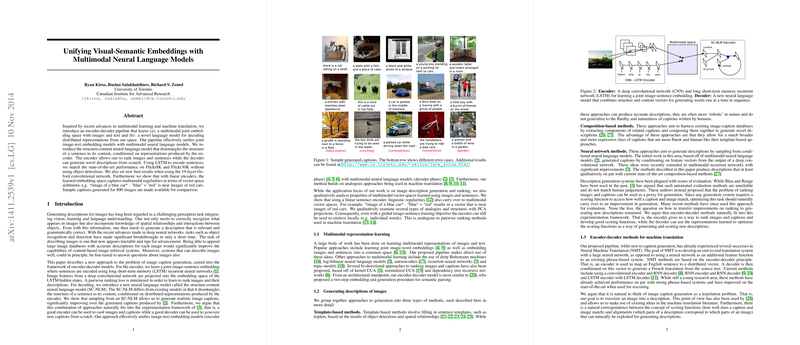Unifying Visual-Semantic Embeddings with Multimodal Neural LLMs
Abstract
The paper introduces an encoder-decoder pipeline that integrates multimodal joint embedding of images and text with a novel LLM for decoding distributed representations. Sentences are encoded using long short-term memory recurrent neural networks (LSTM), and images are encoded via a deep convolutional network. This unified approach, termed the structure-content neural LLM (SC-NLM), successfully separates sentence structure from content. This framework achieves state-of-the-art performance on the Flickr8K and Flickr30K datasets without utilizing object detections, surpassing previous results when applying a 19-layer Oxford convolutional network. Additionally, the paper demonstrates that the embedding space supports multimodal regularities observable through vector space arithmetic, such as modifying the color attribute in image descriptions.
Introduction
The problem of generating descriptions for images is positioned within the context of encoder-decoder models. By learning a joint image-sentence embedding through LSTMs and deep convolutional networks, this approach addresses both image recognition and sentence generation. The SC-NLM model introduced here distinctively factors sentence structures, generating high-quality image captions. This combination aligns with existing frameworks for experimental validation, showing that a robust encoder can rank images and captions effectively, while a strong decoder can generate new captions.
Methodology
The SC-NLM model builds on multimodal neural LLMs and machine translation techniques. Key components include:
- Encoder:
- Joint image-sentence embedding with image features from deep convolutional networks projected into the LSTM-encoded sentence space.
- Minimized pairwise ranking loss to optimize the dual retrieval of images and sentences.
- Decoder:
- The SC-NLM distinctively separates sentence structure from its content, conditioned on representations from the encoder.
- This model uses a multiplicative neural LLM approach to predict the next word in a sequence based on content vectors derived from multimodal embeddings.
Experiments and Results
The model achieves state-of-the-art results on the Flickr8K and Flickr30K datasets. Specifically:
- Without object detection, it equals or surpasses existing models, including those using fragment embeddings and object detections.
- Using the 19-layer Oxford convolutional network further enhances performance, setting new best results across several metrics.
- Conversion tasks and multimodal regularities were explored, showing that simple arithmetic transformations in the embedding space (e.g., swapping colors in descriptions) hold, thereby validating the robustness of the learned space.
Implications and Future Work
Theoretical and Practical Impact:
- Theoretical Significance: By unifying the encoder-decoder paradigm with multimodal embeddings, it provides a robust structure for multimodal representation learning, offering a new perspective on image-to-text translation tasks.
- Practical Applications: Enhancements in image captioning can significantly improve content-based image retrieval systems and conversational AI models.
Future Developments:
- Attentional Mechanisms: Future work could incorporate attention-based models to dynamically adjust focus on different parts of an image, further refining image-caption alignment.
- LSTM Variants: Testing with deep and bidirectional LSTM encoders, as well as integrating LSTM into decoders, could potentially improve both the quality and coherence of generated captions.
The development and successes of the SC-NLM model denote a significant advancement in multimodal embeddings and neural language processing, providing a solid foundation for future exploration and practical applications in image caption generation and beyond.
